Speech Demographics, Productivity and Innovation

Philip Lowe
[*]
Deputy Governor
Speech to The Sydney Institute
Sydney –
- Summary
- Audio 34MB
- Q&A Transcript
Thank you very much for the invitation to address The Sydney Institute. Over many years, the Institute has played an important role in the intellectual and public policy life of our city and our country. It is, therefore, a very real honour to be here.
The title of my remarks is Demographics, Productivity and Innovation. What I would like to do this evening is to step back from the constant flow of high-frequency data on the Australian economy and explore a longer-term issue – namely the potential links between demographic developments, productivity growth and our society's attitudes to risk and innovation.
To try to make these issues a little more concrete, could I begin by asking you to think about two questions:
- How has our society's attitude to risk and innovation evolved over time and what implications are there for productivity growth?
- As the population ages, how might our attitude to risk and innovation continue to change?
These are not easy questions to answer. Understanding how people think about risk and what drives productivity growth are issues that the economics profession has struggled with for many years, with robust answers difficult to come by. As a result, some of what I have to say this evening will inevitably be speculative, and for a central banker that is a slightly uncomfortable thing to do!
Nevertheless, these questions are worth thinking and talking about. Western societies are ageing and productivity growth in many advanced economies has trended lower for some time now. In addition, over recent years, businesses and households in many countries seem to have become more risk averse. The proximate cause of this has been the financial crisis, although I suspect that there might also be deeper factors at work. These developments rightly throw the spotlight onto the issues of how our society generates and funds the innovations that are so important for continued improvement in our living standards.
These issues might seem quite a long way from the short-term setting of the cash rate, which is the main task that keeps the Reserve Bank in the news. But understanding them is critical to doing our job well. Demographic trends and productivity growth are central to understanding how fast the economy can grow without inflation exceeding the medium-term inflation target. And while changes in demography and productivity have little influence on our month-to-month decisions about the cash rate, they do have an important bearing on the average level of the cash rate over time. In effect, they set the contours within which we make our monthly decisions.
So this evening, I would first like to talk about recent demographic trends in Australia and compare those with what is happening in other advanced economies. I would then like to talk about the productivity challenge that lies ahead and the importance of a culture that promotes innovation. And finally, I would like to link the demographic trends to this productivity challenge.
Demographic Trends
First, to demography, which, in my view, we do not talk about enough. Mostly, demographic developments are not deemed to be newsworthy. And in the financial markets, the impending release of demographic information is not met with the same excited anticipation that sometimes accompanies the release of the latest monthly statistics. Yet, demographic developments have profound effects on our economy and on our society.
I would like to draw your attention to three specific developments in Australia.
The first is that our population is growing pretty quickly, and has been for some time. Over the past five years, the population has increased by 9 per cent and it is projected to grow by another 9 per cent over the next five years. The rate of natural increase has tended to slow a little over recent decades, although this has been more than offset by a pick-up in the rate of immigration (Graph 1). The result has been the fastest rate of population increase in more than three decades.
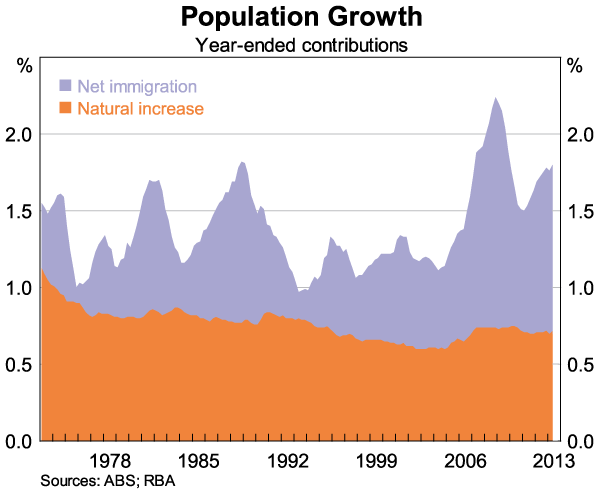
Most other developed economies find themselves in a very different position, with the rate of population growth in the OECD, as a whole, only around one-third of that in Australia (Graph 2). Indeed, our population has been rising at a faster rate than the population of almost any other country in the OECD. In a number of these countries, the population has actually been declining over the past few years and the rate of decline is expected to accelerate. Japan is perhaps the most prominent example here, with the population projected to fall by 10 per cent over the next 20 years, while the working-age population is projected to fall by an almost unprecedented 17 per cent over this same period.[1] These are remarkable numbers.
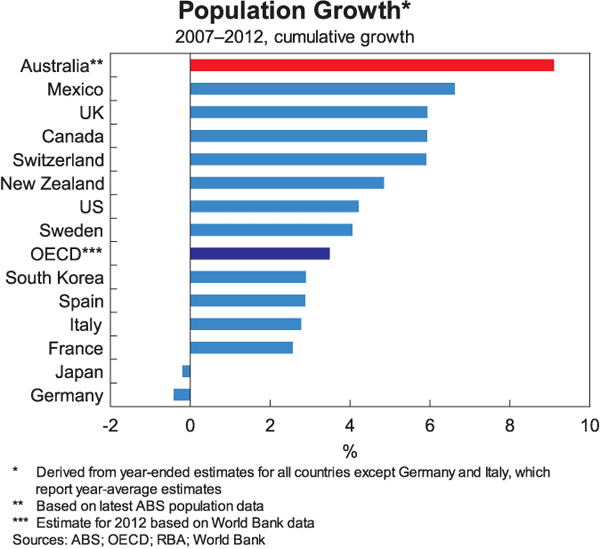
The second aspect of our demography that I would like to draw your attention to is the diversity of our population. According to the latest estimates, 28 per cent of Australia's current population was born overseas (Graph 3). This share has been steadily rising since the 1940s and is currently at its highest level since the late 19th century. This share is also very high by international standards; in most countries, immigrants account for less than 15 per cent of the population, and in quite a few cases the figure is in the low single digits (Graph 4). Among the larger advanced economies, only Switzerland has a higher share of immigrants in the population. It is also worth noting that, on average, new immigrants to Australia are almost 10 years younger than the average Australian. Immigrants are also more likely to have a post-secondary school qualification than the average Australian.
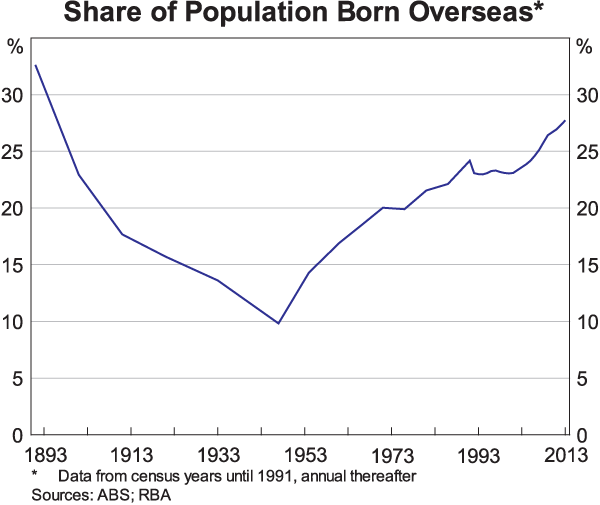
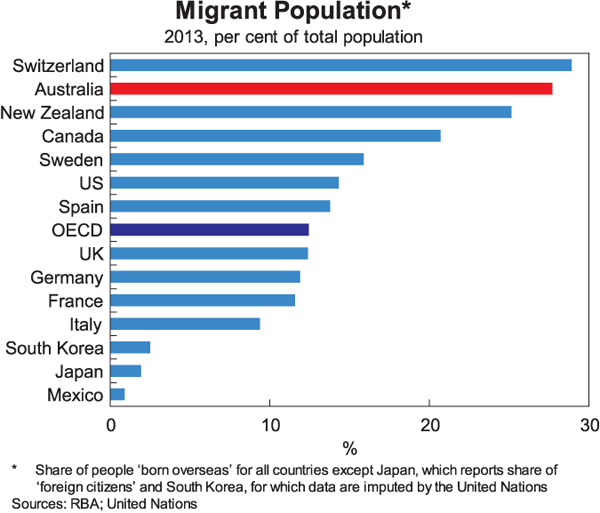
The third aspect of our demography is the ageing of the population. For most of the past 40 years or so we have had somewhat of a demographic dividend. While the share of the population that is over 65 has been steadily rising, this has been more than offset by a decline in the share of children in the population (Graph 5). As a result, the share of the working-age population – defined here as those between 15 and 64 – has trended higher. However, this trend has now turned around and the share of the population in the 15–64 age group is in decline.
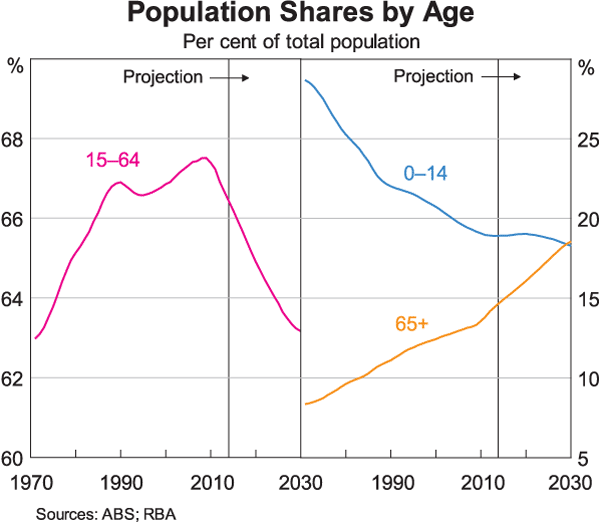
We are starting to see the effect of this demographic transition in the monthly employment data. For many years, the participation rate – that is, the share of the adult population in the labour force – had been steadily rising. In contrast, over recent years, the participation rate has declined and today it is around the same level it was in 2006.
Part of this decline is cyclical, reflecting the current soft conditions in the labour market. But our analysis also suggests that around half of the decline since late 2010 is due to ageing, which is more structural in nature. The results of this analysis can be seen in Graph 6, which shows the actual participation rate (the orange line) along with our estimates of how the participation rate would have evolved had the age structure of the population been constant over time (the blue line). Given the ageing that is taking place, these data imply that the participation rates for the various age groups will need to continue to increase if the overall participation rate is to trend higher again. Whether or not this happens will have an important bearing on the future growth rates of our economy.
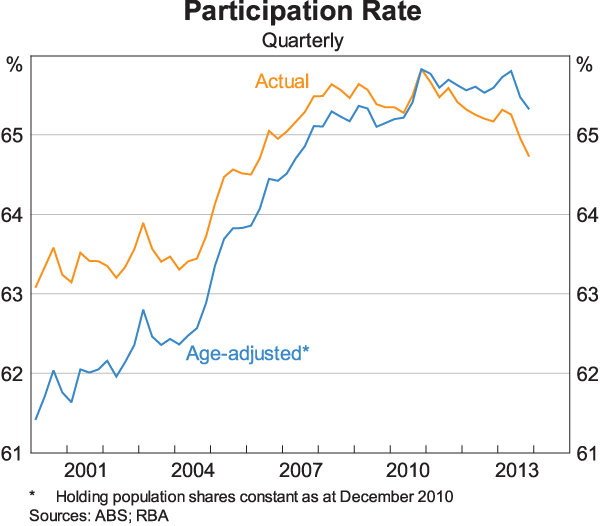
Australia is, of course, not unique in having to deal with the challenge of an ageing workforce. Indeed, the changes taking place in a number of other advanced economies are much starker than those that are taking place here (Graph 7). Our relatively high population growth, which includes a flow of relatively young immigrants, means that a number of countries in Western Europe as well as Japan and South Korea are further along in this journey than we are. From our perspective, this provides us with an opportunity to learn from their experiences.
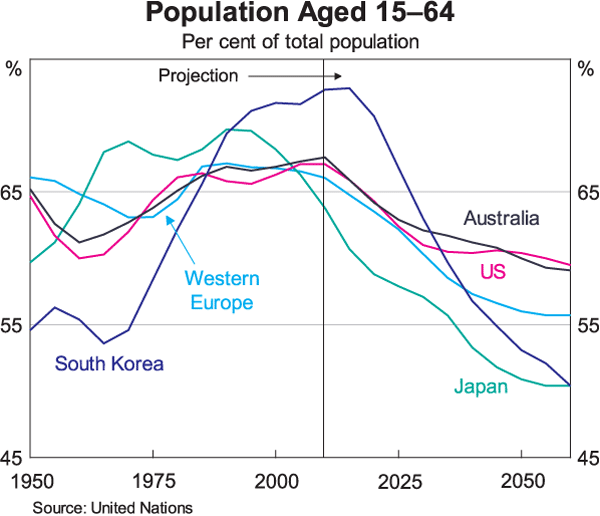
So in summary: our population is growing rapidly, it is increasingly diverse and it is getting older. I will return to these themes in a few moments.
But before I do that, I would now like to turn to the issue of productivity.
Productivity and Innovation
As I have spoken about before, Australia faces a major challenge here.[2] Looking back over the past two decades or so, we have enjoyed faster growth in real per capita income than almost any other advanced economy. In the 1990s, we benefited from strong productivity growth. Then in the 2000s, our collective living standards were boosted by a very large rise in commodity prices. And over much of this period our national income was further increased by the rise in the labour force participation rate that I mentioned a moment ago.
Today things look a little different. Productivity growth over the past decade has been lower than it was in the 1990s, commodity prices are high but no longer rising, and the share of the population in employment has fallen recently. If these trends continue we face the prospect of considerably slower growth in our living standards than we have become accustomed to.
The solution here is to lift our productivity growth.
Again, Australia is not the only country facing this challenge; in almost all developed economies, productivity growth has been slower over the period since the mid 2000s than it was over the preceding decade (Graph 8).[3] There is much debate about why this is the case. One line of thought is that the slowdown is largely a legacy of the financial crisis, which, among other things, caused investment spending in many advanced economies to fall to very low levels.
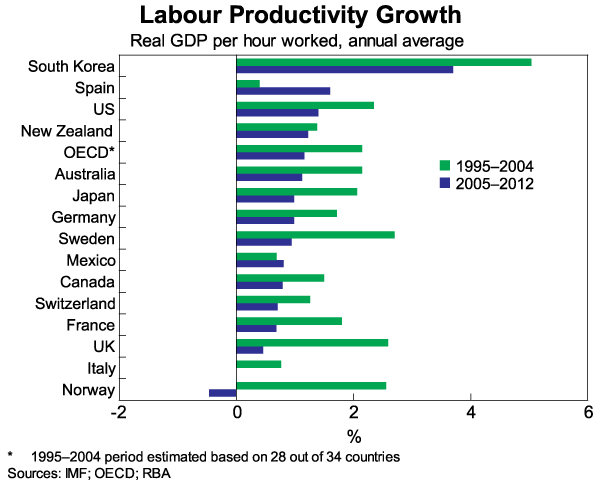
Another line of thought is that the slowdown is much more structural in nature. A prominent advocate of this view is Professor Robert Gordon from Northwestern University. He argues that the first three-quarters of the 20th century was a golden period in terms of productivity growth for the advanced economies. During that period, we worked out how to take full advantage of the transformational inventions of electricity and the internal combustion engine that occurred at the end of the 19th century.[4] While there have been many breakthroughs over recent years, Gordon argues that they pale into insignificance compared with the huge advances made possible by these iconic inventions at the end of the 19th century.
Another sombre assessment is offered by Nobel Laureate Edmund Phelps. He argues that the problem is not so much that we have run out of really great things to invent, but that western societies are now less able to invent them. He argues that cultural changes, including the changed role of government, have stifled the desire and incentives for innovation. As a result, our economies have become less dynamic and less likely to find, develop and make use of the major technological breakthroughs that are the source of much productivity growth.[5]
As is usual in economics though, there is a counterview and it is much more optimistic. This view is that the so-called techno-pessimists are fundamentally wrong and, rather than facing a future of much slower technical progress, we are on the cusp of a new era of great progress in science. A prominent advocate of this view is Robert Gordon's colleague at Northwestern University, Joel Mokyr, who argues that the technological advances of recent times have given scientists a dazzling new range of tools and instruments. These advances have also greatly lowered the cost of accessing information. His argument is that, as a result, a new age of great scientific advancement is now possible.[6]
I don't profess to know which of these views is correct – only time will tell. What underlies these debates though is that the ability of a society to innovate, to take and manage risks and to respond quickly to the changing world helps determine the rate of productivity growth. Improvements in productivity require existing resources to be used more efficiently or advances in technology – they do not occur from doing the same thing over and over again without change.
So if we are to improve efficiency and advance technology then innovation is required and innovation requires someone to take a risk – the risk of trying a different process, the risk of changing workplace organisation and management practices, or the risk of spending scarce resources to explore a new idea. Sometimes the effort will not pay off, but just occasionally it will, and when it does, we find a better process, a more efficient organisational design or an idea that transforms how we do things.
The point I want to emphasise here is that regardless of whether the techno-pessimists or the techno-optimists turn out to be correct, our attitudes to risk-taking, to innovation and to entrepreneurship have a significant influence on our future living standards.
At this point, I would like to return to one of the questions I asked you to think about at the beginning: how has our society's attitude to risk and innovation evolved over time and what are the implications for productivity growth?
My own tentative answer is that there has been a subtle, but important, shift in the way we think about risk and innovation. In particular, our preferences appear to have shifted in such a way that we increasingly focus on risk mitigation and risk control. There are examples of this in a whole range of activities in our society – from the nature of the legislation that parliaments pass, to the increase in compliance activities in the nation's boardrooms, to the amount of money we are prepared to spend to limit the probability of blackouts and even to our attitudes about the design of children's playgrounds. In each of these areas, our society has been prepared to limit options or to spend more of our scarce resources to reduce risk.
I want to make clear that I am not saying that this is necessarily a bad thing. Wealthy societies like our own have considerable capability to address risks in a way that poorer societies cannot. After all, that is one of the benefits of economic progress. And it may also be the case that wealthy societies inherently have less tolerance for certain types of risk than do less wealthy societies. So what we are seeing may well be optimal from the perspective of our collective welfare, even if it does not maximise measured economic growth.
But, at least in my opinion, it is appropriate occasionally to ask whether we have got the balance right. Reducing risks is not always cost free – resources need to be devoted to the task and this means that these resources cannot be used for other tasks. And perhaps even more importantly, it might also be the case that a more risk-averse society is naturally less inclined to support and finance innovation, to implement new processes and to apply new technologies. If this is indeed the case, it has implications for future productivity growth.
Here, I want to circle back to the issue of demography, because some of the developments that I spoke about earlier have the potential to shape how our society thinks about risk, innovation and change in the future. You might recall the second question I asked: how might society's attitude to risk and innovation change as a result of ageing of the population?
Again, there are no definitive answers. Older workers do have considerable accumulated experience that can boost their productivity. However, the available data both in Australia and the United States suggest that individuals in their 30s and 40s have a higher probability of becoming an entrepreneur than do older individuals.[7] The take-up rate for new technologies is also higher for younger workers. In addition, younger people tend to be less risk averse than older people in their financial decisions.[8] All else constant, this higher risk aversion of older citizens means that as the population ages, access to capital for more risky firms, especially start-ups with little business history, is likely to be more restricted and more expensive.
There are, of course, also factors working in the other direction. As the workforce ages, the incentive to find new labour-saving techniques is likely to increase. And the rising pressure on public finances from the ageing of the population should increase the incentive for governments to find more efficient ways of delivering goods and services.
So it is not yet possible to know what the net effect of ageing will be on our attitude to risk and innovation. But, if ageing societies do become inherently more risk averse and less supportive of innovation – as I suspect they might – then we are likely to face a greater challenge than we have to date in generating productivity growth. This means there is likely to be more of a premium on getting policies right in some key areas related to innovation. I would like to mention five of these, although they are by no means exclusive:[9]
- The way in which we finance innovation, including the access to start-up capital for new businesses. The Financial Sector Inquiry will no doubt look at this issue.
- The incentives for innovation that we establish through the tax system.
- The way we support human capital accumulation and research.
- Our business culture and the way we promote and support entrepreneurship.
- The way in which we promote competition in our markets, for it is often competition, or the threat of it, that is the driver of innovation.
These are all challenging areas to get right and they should all be on our collective radar screen if we are to maintain and strengthen the culture of innovation in an ageing society.
I would also like to briefly return to the two other demographic factors that I mentioned earlier, because I think there is a more positive story here. In particular, a reasonable case can be made that both of these demographic factors – that is fairly fast population growth and the increasing diversity of our population – can actually promote innovation.
If the population is growing quickly, then the overall size of the market is getting bigger every year. This dynamism creates new opportunities and can increase the pay-off from taking a risk. And the increasing diversity of our population means that we have a constant influx of people coming to our shores, bringing with them new perspectives, new skills and new ideas. While high population growth and high levels of immigration can create challenges of their own, properly managed, they can also help create a more dynamic economy and a society with more opportunities for all.
So there is a reason for optimism here. In a number of areas, Australia's demographic trends are more favourable than in most other western countries. We have a strong record of adapting to change and allowing the marketplace to guide our adjustment. Our sound macroeconomic and financial frameworks also provide a basis for confidence. The challenge we face is to build on these advantages and to strengthen our collective ability to innovate and to adjust to the changing world. We will need to do this if we are to enjoy the type of growth in our living standards that we have become used to over the past 20 years or so.
Thank you for your time this evening.
Endnotes
I would like to thank David Jacobs, Michelle Bergmann and Daniel De Voss for excellent assistance in the preparation of this talk. [*]
See National Institute of Population and Social Security Research (2012), ‘Appendix: Auxiliary Projections 2061 to 2110’ in Population Projections for Japan (January 2012): 2011 to 2060, January. Available at <http://www.ipss.go.jp/site-ad/index_english/esuikei/gh2401e.asp>. [1]
See Lowe P (2013), ‘Productivity and Infrastructure’, Speech to the IARIW-UNSW Conference on Productivity Measurement, Drivers and Trends, Sydney, 26 November. [2]
This is true of both labour productivity and multifactor productivity growth. [3]
See Gordon RJ (2012), ‘Is US Economic Growth Over? Faltering Innovation Confronts the Six Headwinds’, NBER Working Paper No 18315, August. Available at <http://www.nber.org/papers/w18315> [4]
See Phelps E (2013), Mass Flourishing: How Grassroots Innovation Created Jobs, Challenge, and Change, Princeton University Press, Princeton. [5]
See Mokyr J (2013), ‘Is Technological Progress a Thing of the Past?’, EU-Vox essay, 8 September. Available at <http://www.voxeu.org/article/technological-progress-thing-past>. [6]
See Australian Centre for Enterprise Research (2012), ‘Global Entrepreneurship Monitor, National Entrepreneurial Assessment for Australia – GEM Australia 2011 National Report’, Queensland University of Technology, available at <http://www.gemconsortium.org/docs/download/2414> and Reynolds P and P Davidsson (2009), ‘PSED II and the Comprehensive Australian Study of Entrepreneurial Emergence (CAUSEE)’, in P Reynolds and R Curtin, New Firm Creation in the United States: Initial Explorations with the PSED II Data Set, Springer, pp 265–280. [7]
Data from the Household, Income and Labour Dynamics in Australia (HILDA) survey indicate that individuals over the age of 65 are more likely to report that they are not willing to take financial risks, and less likely to report that they are willing to take above-average financial risks, when compared with the rest of the population (see Black S, L Rogers and A Soultanaeva (2012), ‘Households' Appetite for Financial Risk’, RBA Bulletin, June, pp 37–42). [8]
See Banks G (2012), ‘Productivity Policies: The “To Do” List’, Speech at the Economic and Social Outlook Conference, ‘Securing the Future’, Melbourne, 1 November. Available at <http://www.pc.gov.au/__data/assets/pdf_file/0009/120312/productivity-policies.pdf>; Daley J, C McGannon and L Ginnivan (2012), ‘Game-changers: Economic Reform Priorities for Australia’, Grattan Institute, Melbourne. Available at <http://grattan.edu.au/static/files/assets/bc719f82/Game_Changers_Web.pdf>; and Department of Industry (2013), Australian Innovation System Report, Department of Industry, Canberra. Available at <http://www.innovation.gov.au/science/policy/AustralianInnovationSystemReport/AISR2013/wp-content/uploads/2013/11/AIS-Innovation-Systems-Report-2013-v3.pdf>. [9]